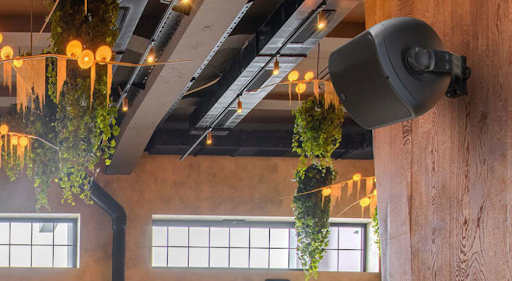A café can feel bright at breakfast and calm by late afternoon without changing a single chair. Sound carries that shift. Customers cross the threshold, catch a gentle rhythm, and settle into the pace of the room. The choice of where music comes from matters as much as the playlist, because a speaker’s position changes how bodies move and how voices rest.
In many cafés, commercial audio speakers do the quiet work of shaping mood. Ceiling units paint even circles over tables so people hear detail without raising their voices. Wall mounts near the queue keep focus at the counter, which reduces small delays and makes service feel smooth. A compact sub under seating adds weight only where it helps, so coffee sounds warm but never boomy.
Placement begins with a simple rule. Put sound near people, not in far corners. A row of fixtures down the center creates a steady path that guides guests from door to menu to pickup. Angles matter. Point too wide and the room gets splashy. Aim too high and cymbals get sharp. A few degrees of tilt can turn glare into glow.
Tempo and tone play their part, but position sets the stage. Breakfast hours may want crisp tracks with quick endings, which encourage turnover. Midday often benefits from softer layers that leave space for talk. Evenings tend to slow down. None of these choices work if coverage is patchy. People will lean in or raise their voices, and fatigue follows. Consistent fields let the music sit just above the noise floor, where it guides without pushing.
Stores juggle different needs. Entrance zones deserve a little lift to mark arrival. Aisles perform better with narrow beams that keep sound on the products, not in the walkway. Fitting rooms want privacy, so designers lower level there and soften the highs. At the checkout, speech must stay clear at low volume, which means pulling back bass that can mask consonants. Careful placement makes these goals possible without constant tweaks.
Data helps without taking over. A microphone near the door measures street noise and asks the system to nudge level by a decibel or two when traffic peaks. Another sensor listens for buildup in the low band when the room fills. The processor trims a narrow slice and restores balance. Staff keep eyes on guests rather than on a screen full of sliders. The rig does the background work.
With the right aim and height, designers use commercial audio speakers with tight patterns to frame islands of calm. Seating areas keep warmth. Queues keep clarity. Children’s corners stay gentle. When sources sit closer to listeners, everyone hears similar detail at modest volume. The effect feels fair. No one fights a hotspot or a dead zone, and no one near a wall takes the brunt of the mix.
Accessibility sits inside the plan, not as an afterthought. Clear announcements for names and orders help everyone, especially guests who rely on hearing aids. Loop systems work better when the base level is even. Consistent placement also supports captions on menu screens, because voices and text arrive at the same spot without delay.
Maintenance keeps the mood from drifting. Before doors open, a short test track reveals a loose mount or a failed channel. Dust gets wiped from grilles. Settings get saved to locked scenes for morning, lunch, and close. If a unit goes out during service, the matrix reroutes a neighbor to cover the gap until a swap arrives.
When commercial audio speakers sit at the correct height and aim, the room feels even without turning the dial. A café can move from bright to relaxed with a small change in tempo and a tiny shift in level. A store can invite browsing without drowning talk. Mood comes from intention, not from sheer loudness. Place sound with care, and the day will carry its own rhythm.
For More Info Visit:- flywiththought.com





